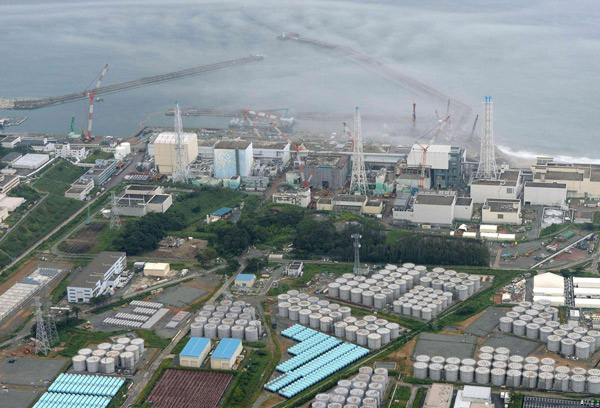Japan to fund leak control measures at nuke plant
 |
|
An aerial view shows Tokyo Electric Power Co. (TEPCO)'s tsunami-crippled Fukushima Daiichi nuclear power plant and its contaminated water storage tanks (bottom) in Fukushima, in this file photo taken by Kyodo August 20, 2013.[Photo/Agencies] |
TOKYO - Japan will fund some of the costly, long-term projects to control the worrisome and growing leaks of contaminated water at the crippled Fukushima nuclear plant.
Public funding is part of several measures the government adopted Tuesday. Most were already announced but they are widely seen as a safety appeal before the International Olympic Committee votes on which city will host the 2020 Olympics. Tokyo is a front-runner.
The operator of the Fukishima Dai-ichi plant says hundreds of tons of radioactive underground water have been leaking into the sea daily since early in the crisis, caused by the 2011 earthquake and tsunami. Several leaks from storage tanks in recent weeks have added to concerns that the plant is unable to manage the radioactive water.
On Monday, Japan's top nuclear regulator raised safety concerns about the hastily built storage tanks and their foundations after signs of new leaks.
One was found over the weekend in a connecting pipe, and plant operator, Tokyo Electric Power Co., said it suspects three storage tanks where elevated radioactivity was detected also have had leaks.
Nuclear Regulation Authority Chairman Shunichi Tanaka told a news conference that the small leak and possible other leaks have added to concerns about the plant's stability.
They follow a major leak two weeks ago. TEPCO reported a loss of 300 tons of highly radioactive water from a steel tank on August 19, saying most of it is believed to have seeped underground but some might have escaped into the sea. The company has yet to determine the cause or exactly where the water went.
More than 300 tanks there are of a similar type. About 1,000 tanks hold 330,000 tons of contaminated water at the plant, and the amount grows by 400 tons daily. The water is part of the makeshift system to keep the radioactive material at the plant stable.
Tanaka said he believed the discoveries of the subsequent leak and signs of possible additional leaks were the result of closer inspections after the large leak two weeks ago. That leak was the worst from a tank at the plant, which was badly damaged by a massive March 2011 earthquake and tsunami.
The investigation into the tanks has revealed sloppy record keeping and tank management by TEPCO. The company has acknowledged that it used to assign only two workers to visually inspect all 1,000 tanks in about two hours until the leak, and none of the tanks had water gauges. TEPCO has increased the patrol staff to nearly 60 and is adding other early detection measures.
TEPCO also said it overlooked several signs of leaks _ increases of radioactivity near the tanks and higher exposure levels for workers _ for more than a month.



























